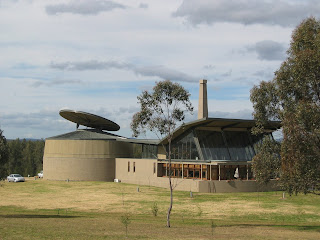

TWO OUT OF MANY HUNTER VALLY MODERN WINERIES.
Before leaving for Sydney we played a round of golf at the Hunter Valley Golf and Country club, a pretentious name that did not live up to its lofty promise. For example, at the time we visited there was no golf clubhouse, as the facility was alleged to be under redevelopment — but there was not much earth being moved that I could see. However, the golf course was fair and reasonable, with a round costing about $35 each. We also visited a resort development associated with Greg Norman. It had potential but oddly, although almost all the currently available lots were sold, only two houses had been built. As in the rest of Australia, there seems to be a lot of property speculation, with, I believe, most people buying the lots in hope of selling them later…perhaps only building if development really takes off. It doesn’t give a prospective purchaser a very good feeling about buying in. Besides, I later learned that the Hunter Valley has only two seasons, spring and fall, with summer temperatures often going above 100 degrees. It was likened to Phoenix in the summer; very hot and dry.
Thursday morning in August found us almost alone in the valley. It was a pleasant day, with temperatures in the mid 60s, but there were very few people about. Hunter Valley competes with many other wine regions we visited spread throughout Australia: south near Adelaid, on the west coast below Perth, the Borrosa valley and so forth. But Hunter Valley is likely to be the oldest, given its proximity to Sydney. Since neither Elysee nor I are one’s to gush over visiting wineries, we selected a couple small tasting rooms, bought a bottle as a gift for our host at Friday’s dinner party, and left for Sydney, my guide and companion insisting we drive only during daylight hours. Elysee’s wine tasting lexicon is still on my mind:
Color: Bruised Purple Thigh
Nose: Snotty
Palette: Wet
Taste: Wood chips and computer chips (maybe some potato chips)
Enjoy now or cellar for 5 to 8 years at an annual return of 3.5









